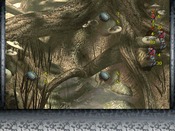Reply to Crazy Old Tim Plays All the DMODs of 2007
If you don't have an account, just leave the password field blank.
--Crazy Old Tim Plays All the DMODs--
Directory
1998 | HTML version
1999 | HTML version
2000 | HTML version
2001 | Article version
2002 | Article version
2003
2004
2005
2006
2008-2009
2010
2011-2015

Any discrepancies between this and the chart I made in the first topic are mistakes that I made and have since corrected.
Don't call it a comeback; Dink's been here for years.
In a wild deviation from the overall downward trend, 35 DMODs were released in 2007, putting it up there with the highest peak of four years earlier. Put another way, 2007 accounts for a little over a third of all DMOD releases between the end of 2006 and the present. This may be partially accounted for by the fact that Skull released a record-breaking TEN DMODs (!!) in 2007, some under various alternate pseudonyms. Skull has been warning me about these DMODs since I started, so this could get a little... bumpy.
I'll actually be covering 36 DMODs in this topic because of yet another mistake that I've made.
247: Dink Goes Beachcombing Author: RadFrog Release Date: January 8, 2007
"WARNING, No life guard on duty"
All of the DMODs on the site are supposed to be in the .dmod format nowadays, and so far, that's been true. It's odd to encounter an exception in a DMOD that came out AFTER the site settled on the .dmod standard, but "Dink Goes Beachcombing" inexplicably comes in .zip form.

A rare one-button title screen.
The author states in the description and readme that this DMOD is "not a real adventure" and was only created to learn about DinkC and WinDinkEdit. Indeed, there's not much of a point and no win condition. The map is just a series of nearly identical beach screens laid out horizontally, and there's no music. Each screen contains some sort of event that the author used to learn something like variable use, cutscenes with walking and speaking characters, visions, or implementing a custom graphic.
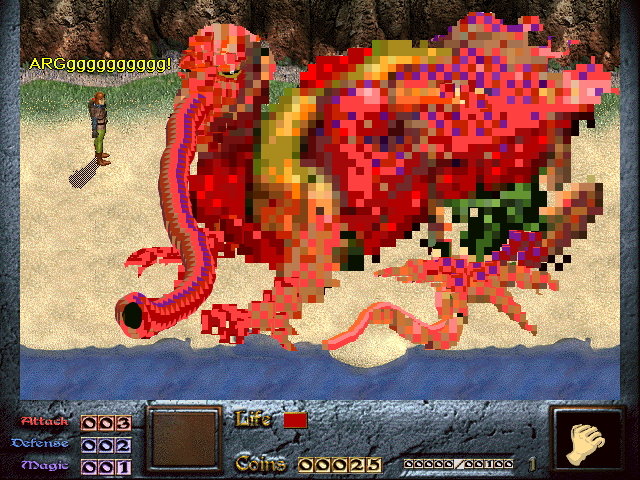
This is the new graphic, the "Slippery Dee." It is godawful ugly. It's also composed mainly of sprites from Dink. See the dead girl body?
It's a good idea to create a "test DMOD" to get experience before making a real one. I wish I had done something like this before releasing the likes of "Dink Forever." Actually releasing it, though, is a bizarre thing to do. There's no value to this except the value that the author got from making it.
Furthermore, there are a few problems. When Dink examines an inanimate object, his remarks appear above the object rather than Dink, making it look like the bowl or whatever is talking. Dink is supposed to get hung up on the "Slippery Dee" when heading east and have to turn around and go west before eventually coming back, but there's a gap in the hardness that allows you to walk right past the Dee. The author knew about this (he said so in the readme) but didn't bother to fix it.
If you do walk all the way east, there's a chest that dispenses dragons when you punch it. The dragons don't cast spells, but their touch damage will wipe Dink out instantly. This is the only way to end the game besides quitting.
Releasing this was a bad idea, and I really ought to be giving it the DFMAOB, but I dunno. Something about the author's open self-awareness, the enjoyment they seemed to get out of learning, and a certain good-natured goofiness about the mod makes me want to stay my vengeful hand... this time. But there's really no reason for anybody to play this. Ever.

An example of goofiness: this is the "map."
248: I, Kara Gu Author: Neil Troughton (Arik) Release Date: February 6, 2007
"Man, they've really got it in for me, haven't they?"
REPUTATION NOTE: This DMOD is one of the select group with a score of 9.0 or better (9.2) on The Dink Network.
Wow. Why didn't anybody tell me about this one? I guess I should be glad I didn't play it until now. If I'd known a DMOD like this existed before making "Malachi the Jerk," I probably would have given up on the idea of making a DMOD that was going to impress anybody.
"I, Kara Gu" does more to change the basic Dink Smallwood gameplay than any other DMOD that doesn't just throw out the genre entirely and make a completely different kind of game. You play as Kara, a young initiate of a magical society called the Gu. Kara is not an adventurer like Dink and just about every alternate hero we've played as. She doesn't carry an inventory and won't even try to punch things. Instead, she uses fire and water magic.
The new magic system is the center of this DMOD. You can cast spells in rapid succession, or you can wait for the magic meter to fill and cast a more powerful version of the spell. The fire spells are similar to the fireball and hellfire and the water spells are similar to the acid rain spell from the original game, but the spells have been carefully tweaked and improved. The balance is much better than it was in the original. The fireball's damage has been made consistent, making it more useful. The water magic is a revelation, taking the usually ignored acid rain and making it great. The damage has been increased, and as long as you've still got water magic equipped, the rain no longer damages you. The strong version of the spell does even more damage, moves forward slowly (great to ensure repeated hits on a lot of enemies) and has a neat "thunderstorm" look. It's so boss.
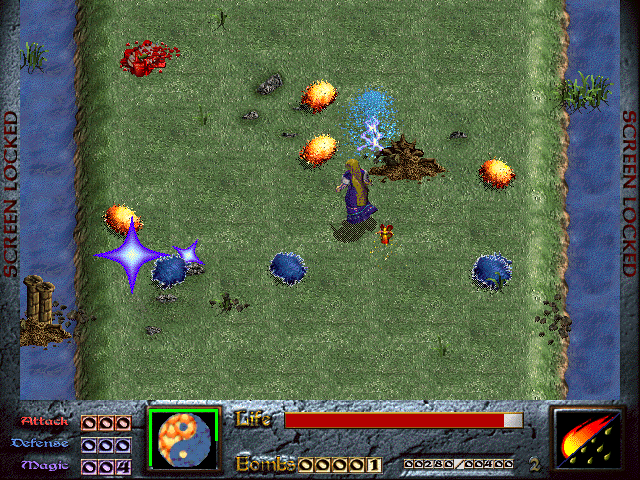
Kara strikes down her enemies with powerful water.
You don't switch magic by using the inventory screen. Instead, the attack button is used to cast spells, and you press the magic button to switch between fire and water. This also changes the color of Kara's dress and the color of her text. Arik uses a function new to 1.08 (set_font_color) to make Fire Kara's text red, which is not one of the default colors. I didn't realize how much Dink Smallwood had been missing red text until I saw it in this game. It is beautiful.

I did, so you may more easily admire the red text. Well, that's a lie. But still.
Most enemies and attacks in "I, Kara Gu" have a fire or water element. Enemies take more damage from the spell whose element is opposite theirs. Attacking an enemy with its own element will cause it to become much faster, so you're usually (but not always) better off avoiding it. Kara herself is immune to damage from non-melee attacks with the same form, creating an interesting dynamic in which you have to balance doing more damage to enemies against the fact that you're more vulnerable to their attacks if you're the opposite element from them. Taking advantage of your immunity to damage from same-colored attacks is key to doing well in this game.

Flames don't bother Fire Kara, but a puddle is deadly.
You can only change forms when your magic meter is full, a fact that is very important to the way the game is played. There are puzzles involving giant red and blue laser beams, and you have to plan ahead so you'll be able to switch at a key moment to avoid damage. Especially in later sections, the screen is frequently full of various attacks, and staying in the path of the same-colored attacks is a lot easier than just trying to avoid them all. At times, this DMOD feels like playing a "bullet hell" shoot 'em up. Actually, the colored damage mechanic strongly reminds me of Ikaruga. I wonder if Arik was inspired by that game.
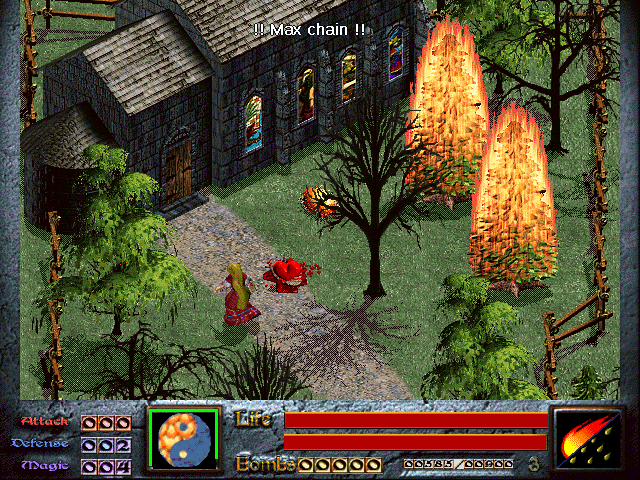
Well, that answers THAT question.
Many DMODs have tried to vary the combat by introducing new magic attacks, but I've never seen any new spells or attacks that were as carefully considered as the magic in "I, Kara Gu." Usually, even in a good DMOD my reaction to at least one of the new abilities is "that's neat, but it isn't very useful." Here, everything matters. You might think that you're better off waiting for the magic meter to fill to use your more powerful attacks, but it's actually dependent on the specific situation you're in. It's important to get a feel for when you should use the quick magic (most of the time) and when it's a good idea to wait for the full magic (there are times when it's a great idea). It all feels so damn good. It felt like I was playing a different game than Dink Smallwood. A better one, frankly.
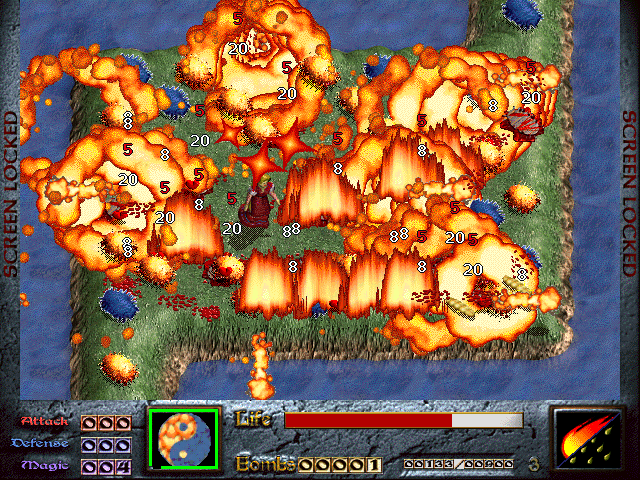
What a rush!
"I, Kara Gu" features branching paths and multiple endings. This is always a risky thing to do, as you're making it impossible to see all of your game in one play, and you risk trying the player's patience. "Friends Beyond 2" tried to do this, but in that game, it was confusing, horribly unbalanced and seemed oddly disconnected from the player's actions. Here, it's handled much better. The branching points are handled in a smart way, making it very clear to the player that they have a decision to make without obtrusively pointing it out. Small clues are presented to what a certain path is going to entail without breaking immersion at all.

Up or down? Bloody conflict, or a meadow?
The first and final sections are the same whatever path you take, but there are completely separate areas to play as the game splits once early on and then again later. Each path reveals different aspects of the story. Each path also features different bosses.

This graphic works much better as a Gradius-style "core" boss than it ever did as an alternate save machine.
Ah, those bosses. Each one has a name that slides onto the screen just before you fight them (I love touches of presentation like this). Arik showed in "Cloud Castle 2" what impressive variety can be achieved with bosses in a more "normal" DMOD, but the bosses here are taken to a new level. People often complain in reviews on the Dink Network about boss fights that they consider overly long, and although that criticism has been directed at my own work, I can see where they're coming from. Most fights in DMODs are pretty monotonous, after all. Dink Smallwood is all about hitting and running, and there's a limit to how well you can do at that. When you get close to the enemy to deliver a hit, you risk getting smacked even if you're doing everything right. But in "I, Kara Gu," the combat is different. Boss fights are complex and involve a high level of skill from the player. The length of the fights allows them to build tension to a maddening degree as you struggle to keep going without messing up, and I think this is mostly a good thing.

There are many different bosses, like these "guardian spirits." One of them shoots wildly and the other follows you closely.
The gameplay is the focus of this arcade-like game, but the story is also well-executed. Kara is sixteen, and it's her day of initiation into the Gu. She was left at the secluded order's enclave as a child. It's easy to identify with her discomfort at the path she's been forced onto. I like the village, too. Before the action starts (at which point there is rarely a break), you get some time to explore it, and it develops a personality. It seems like the sort of place Dink would encounter during one of his epic adventures, and there is in fact a monument stating that Dink visited the place at some point. Depending on which path you take through the game, different elements of the story that are set up at the start will be resolved. On one path, you'll learn about Kara's real mother; another path resolves the conflict between Kara and Samantha, a Milder-type character who's always been a thorn in her side.
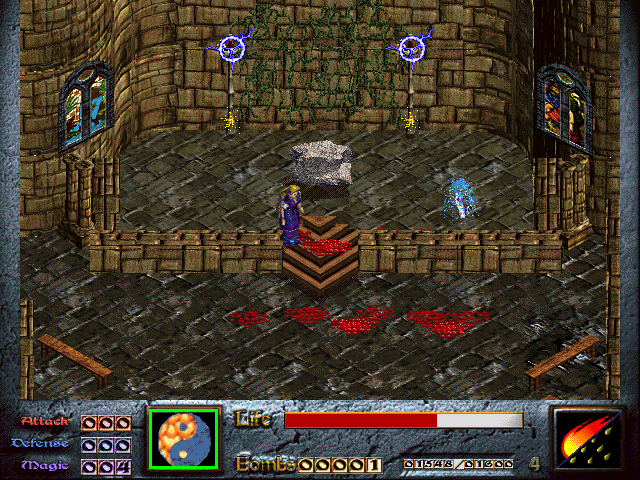
The decoration in this game is really cool. Look at those sparking effects. A lot of the background elements seem to make sense as machines or mystical objects.
On my first play through the game, I took the path that ends with Kara turning evil. There's a delightful ending (my favorite) in which she becomes an evil overlord and we see various scenes from a Dink Smallwood quest that ends with Dink confronting her. They have some typical hero-villain dialogue (with a bit more self-awareness than usual from the villain), and it fades down just as the battle between Dink and Kara begins. Perfect.
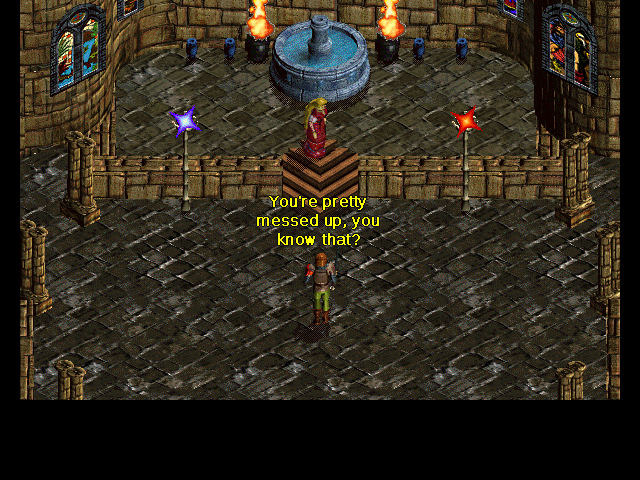
"I have an inkling."
I found this path particularly interesting because I didn't really set out to be evil. Usually, games that allow you to go down some kind of "evil path" require a conscious decision from the player to just go around being a dick to people. Here, Kara starts down that path by reacting in a pretty natural way to people who are trying to destroy her for reasons that aren't her fault and which she doesn't fully understand yet. Before you know it, she's mowing down hordes of supposedly good wizards. This doesn't come out of nowhere - in an example of how clever the branching system is, you have to murder a wizard who's standing in your way, threatening you but not attacking, before you're on the "evil" path - but it's a pretty seamless transition.
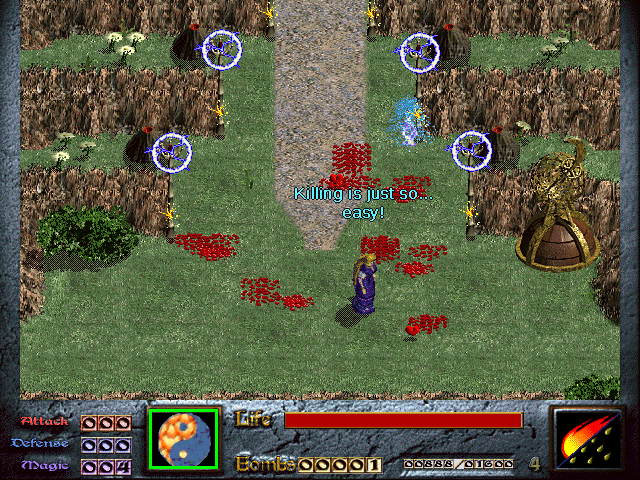
Yikes.
At the start you're allowed to choose between "Easy" and "Normal" difficulty. I never learn my lesson. I played on normal on my first run, and the game does not mess around. It wasn't easy getting to the end, but nothing could prepare me for the final boss. She's the "holy mother" of the Gu gone rogue, and she has a hojillion phases. The bitch just WILL NOT DIE.

I am feeling genuine hatred just looking at this screenshot.
Most video games nowadays are pretty easy. The predominant school of thought seems to be that pretty much everybody ought to be able to win. I'm not saying this is entirely a bad thing. After all, people finish the games they buy pretty infrequently anyway, and you don't want your players giving up. The difficulty of old games wasn't necessarily a good thing, either. A lot of old games were straight up horsesh*t. I'm talking monstrously unfair, designed to make children cry. The worst cases of this - games that are willing to make you redo whole levels on a coin flip - are rightly remembered as terrible, but even a lot of "classics" are full of fake or unfair difficulty that is just wretched, fun-murdering design.
But there is something special about that masochistic experience of an unyielding, yet fair video game challenge. It seems insurmountable, but when you lose, you know that it's ultimately your fault for not being good enough. I've run into quite a few DMODs that were too hard for me to beat, but I never had this sort of experience with one until now.
I'm not great at video games. It kind of sucks that I'm not more skilled at something I've spent (some would say wasted) so much of my life doing, but I guess my potential just isn't very high. But you know, there's another way besides skill to win at difficult video games.
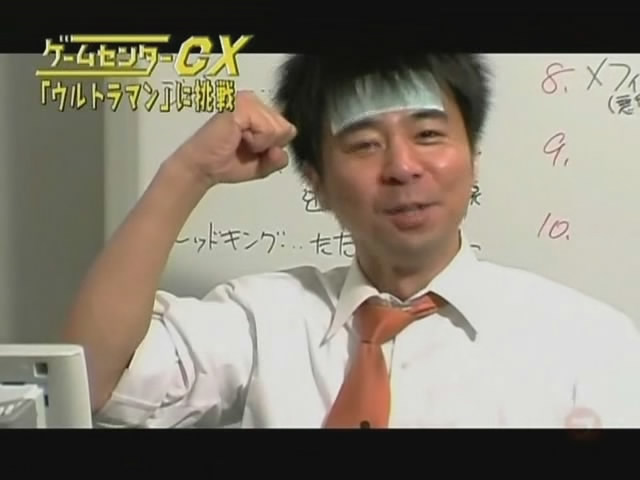
This is Shinya Arino, the star of the Japanese TV show Game Center CX. He is not good at video games. Actually, he's considerably worse at them than I am. But in each episode, he is challenged to beat a different retro game, and he usually ends up winning. Even though he kind of sucks at games, he's beaten some of the hardest ones out there. Battletoads. Contra (no Konami code). Mighty Bomb Jack. Tough, tough games. And he beats them because this man is indomitable. He never gives up, and he always keeps a positive attitude. It is inspiring to watch. "100% Persistence" is his motto.
Drawing upon my inner Arino, I doggedly pursued the ending of "I, Kara Gu" on normal difficulty. I don't know how long it took me to beat the boss. More than an hour, I know that. Probably more than two. It's standard procedure on the Internet to tell people who say they struggled at a game that they suck and it's easy, but hey, I already said I'm not so great at games, and I meant it. Your words cannot hurt me.

Do you know what it's like? Let me try to explain. At first, it doesn't bother you much when you lose. You're just getting your bearings. There's a long road ahead. You get further with each attempt. Things seem to be going well. You're sure that you'll reach the end soon.
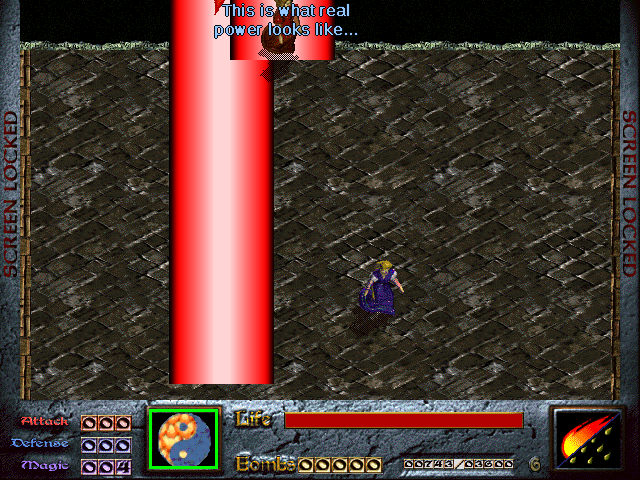
But there's another form, and another, and another. Surely THIS is the last one, you think... but it isn't. And that's when you hit the Wall. You plateau. You die on the same part, over and over.
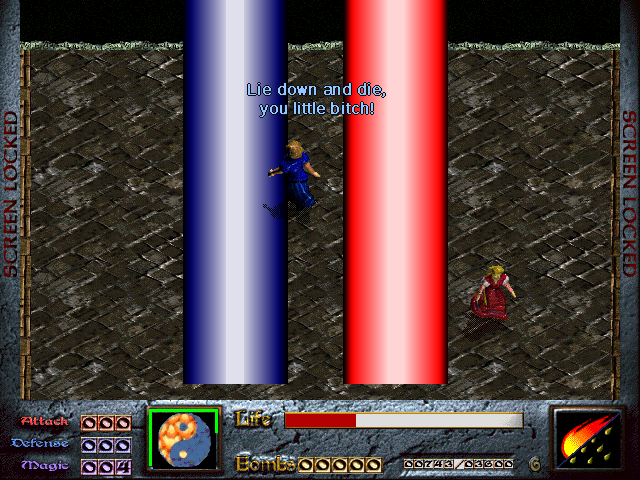
The frustration starts to build. Your pulse quickens, your focus tightens. You begin to take your task - your alleged entertainment - very seriously. You won't be beaten. Finally, you break through the Wall. You break your old record. Hell, you shatter it. Nervous and slightly giddy at how well you're doing, you can't believe how much more there was after the Wall or how little any of it is bothering you. You get very, very close to actually winning - within a hit or two, although you might not know it yet. This part is always removed from your eventual victory by at LEAST half an hour.

After that, you get worse. You can't maintain the focus. You don't even approach the old Wall anymore. You die on the easy parts, the parts you had considered a joke from attempt one. Depression sets in. "I suck at this." "Why am I trying so hard at this video game?" "I shouldn't be playing a game where I'm not having fun." "I'll never win; I should give up." But you don't. For some reason, you don't.

Then you enter the Numb Zone. It's not quite that you don't care anymore, but you've been beaten down so many times that you no longer feel it. It's almost serene. Robotically, you repeat the same motions again and again. Then, you decide to try something different. You haven't tried it yet because it seems like a dumb idea, but at this point, you're so numb that you'll try anything. And it turns out to not be as dumb an idea as you thought. Maybe it's not the best strategy, but it seems to be the best strategy for you and your brain's particular set of flaws. In this case, I decided to stop trying to stay ahead of the boss's element changes and just stay one element almost all of the time.
This didn't yield results immediately - the Crazy New Strategy always makes you worse at first - but when I broke through, I had room to spare.
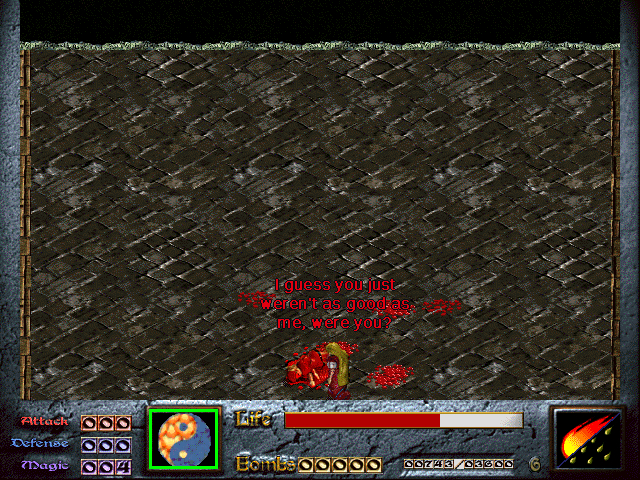
SAY MY NAME, BITCH.
I played again (on Easy!) and found a second ending, a more standard "good" ending. I went for a third, but got stuck on a certain part and ran, at last, out of patience. I watched the rest of it on DSPT.
You know, I don't have much to criticize. The early section of the game where you have either a fire or water item and have to take a different path depending on which your carrying could have used clearer indication of which path was which. I was mildly annoyed when I went the wrong way and had to backtrack. But come on, that is one Hell of a nit to pick. "I, Kara Gu" is the best DMOD. You guys have been holding out on me.
Directory
1998 | HTML version
1999 | HTML version
2000 | HTML version
2001 | Article version
2002 | Article version
2003
2004
2005
2006
2008-2009
2010
2011-2015

Any discrepancies between this and the chart I made in the first topic are mistakes that I made and have since corrected.
Don't call it a comeback; Dink's been here for years.
In a wild deviation from the overall downward trend, 35 DMODs were released in 2007, putting it up there with the highest peak of four years earlier. Put another way, 2007 accounts for a little over a third of all DMOD releases between the end of 2006 and the present. This may be partially accounted for by the fact that Skull released a record-breaking TEN DMODs (!!) in 2007, some under various alternate pseudonyms. Skull has been warning me about these DMODs since I started, so this could get a little... bumpy.
I'll actually be covering 36 DMODs in this topic because of yet another mistake that I've made.
247: Dink Goes Beachcombing Author: RadFrog Release Date: January 8, 2007
"WARNING, No life guard on duty"
All of the DMODs on the site are supposed to be in the .dmod format nowadays, and so far, that's been true. It's odd to encounter an exception in a DMOD that came out AFTER the site settled on the .dmod standard, but "Dink Goes Beachcombing" inexplicably comes in .zip form.

A rare one-button title screen.
The author states in the description and readme that this DMOD is "not a real adventure" and was only created to learn about DinkC and WinDinkEdit. Indeed, there's not much of a point and no win condition. The map is just a series of nearly identical beach screens laid out horizontally, and there's no music. Each screen contains some sort of event that the author used to learn something like variable use, cutscenes with walking and speaking characters, visions, or implementing a custom graphic.

This is the new graphic, the "Slippery Dee." It is godawful ugly. It's also composed mainly of sprites from Dink. See the dead girl body?
It's a good idea to create a "test DMOD" to get experience before making a real one. I wish I had done something like this before releasing the likes of "Dink Forever." Actually releasing it, though, is a bizarre thing to do. There's no value to this except the value that the author got from making it.
Furthermore, there are a few problems. When Dink examines an inanimate object, his remarks appear above the object rather than Dink, making it look like the bowl or whatever is talking. Dink is supposed to get hung up on the "Slippery Dee" when heading east and have to turn around and go west before eventually coming back, but there's a gap in the hardness that allows you to walk right past the Dee. The author knew about this (he said so in the readme) but didn't bother to fix it.
If you do walk all the way east, there's a chest that dispenses dragons when you punch it. The dragons don't cast spells, but their touch damage will wipe Dink out instantly. This is the only way to end the game besides quitting.
Releasing this was a bad idea, and I really ought to be giving it the DFMAOB, but I dunno. Something about the author's open self-awareness, the enjoyment they seemed to get out of learning, and a certain good-natured goofiness about the mod makes me want to stay my vengeful hand... this time. But there's really no reason for anybody to play this. Ever.

An example of goofiness: this is the "map."
248: I, Kara Gu Author: Neil Troughton (Arik) Release Date: February 6, 2007
"Man, they've really got it in for me, haven't they?"
REPUTATION NOTE: This DMOD is one of the select group with a score of 9.0 or better (9.2) on The Dink Network.
Wow. Why didn't anybody tell me about this one? I guess I should be glad I didn't play it until now. If I'd known a DMOD like this existed before making "Malachi the Jerk," I probably would have given up on the idea of making a DMOD that was going to impress anybody.
"I, Kara Gu" does more to change the basic Dink Smallwood gameplay than any other DMOD that doesn't just throw out the genre entirely and make a completely different kind of game. You play as Kara, a young initiate of a magical society called the Gu. Kara is not an adventurer like Dink and just about every alternate hero we've played as. She doesn't carry an inventory and won't even try to punch things. Instead, she uses fire and water magic.
The new magic system is the center of this DMOD. You can cast spells in rapid succession, or you can wait for the magic meter to fill and cast a more powerful version of the spell. The fire spells are similar to the fireball and hellfire and the water spells are similar to the acid rain spell from the original game, but the spells have been carefully tweaked and improved. The balance is much better than it was in the original. The fireball's damage has been made consistent, making it more useful. The water magic is a revelation, taking the usually ignored acid rain and making it great. The damage has been increased, and as long as you've still got water magic equipped, the rain no longer damages you. The strong version of the spell does even more damage, moves forward slowly (great to ensure repeated hits on a lot of enemies) and has a neat "thunderstorm" look. It's so boss.

Kara strikes down her enemies with powerful water.
You don't switch magic by using the inventory screen. Instead, the attack button is used to cast spells, and you press the magic button to switch between fire and water. This also changes the color of Kara's dress and the color of her text. Arik uses a function new to 1.08 (set_font_color) to make Fire Kara's text red, which is not one of the default colors. I didn't realize how much Dink Smallwood had been missing red text until I saw it in this game. It is beautiful.

I did, so you may more easily admire the red text. Well, that's a lie. But still.
Most enemies and attacks in "I, Kara Gu" have a fire or water element. Enemies take more damage from the spell whose element is opposite theirs. Attacking an enemy with its own element will cause it to become much faster, so you're usually (but not always) better off avoiding it. Kara herself is immune to damage from non-melee attacks with the same form, creating an interesting dynamic in which you have to balance doing more damage to enemies against the fact that you're more vulnerable to their attacks if you're the opposite element from them. Taking advantage of your immunity to damage from same-colored attacks is key to doing well in this game.

Flames don't bother Fire Kara, but a puddle is deadly.
You can only change forms when your magic meter is full, a fact that is very important to the way the game is played. There are puzzles involving giant red and blue laser beams, and you have to plan ahead so you'll be able to switch at a key moment to avoid damage. Especially in later sections, the screen is frequently full of various attacks, and staying in the path of the same-colored attacks is a lot easier than just trying to avoid them all. At times, this DMOD feels like playing a "bullet hell" shoot 'em up. Actually, the colored damage mechanic strongly reminds me of Ikaruga. I wonder if Arik was inspired by that game.

Well, that answers THAT question.
Many DMODs have tried to vary the combat by introducing new magic attacks, but I've never seen any new spells or attacks that were as carefully considered as the magic in "I, Kara Gu." Usually, even in a good DMOD my reaction to at least one of the new abilities is "that's neat, but it isn't very useful." Here, everything matters. You might think that you're better off waiting for the magic meter to fill to use your more powerful attacks, but it's actually dependent on the specific situation you're in. It's important to get a feel for when you should use the quick magic (most of the time) and when it's a good idea to wait for the full magic (there are times when it's a great idea). It all feels so damn good. It felt like I was playing a different game than Dink Smallwood. A better one, frankly.

What a rush!
"I, Kara Gu" features branching paths and multiple endings. This is always a risky thing to do, as you're making it impossible to see all of your game in one play, and you risk trying the player's patience. "Friends Beyond 2" tried to do this, but in that game, it was confusing, horribly unbalanced and seemed oddly disconnected from the player's actions. Here, it's handled much better. The branching points are handled in a smart way, making it very clear to the player that they have a decision to make without obtrusively pointing it out. Small clues are presented to what a certain path is going to entail without breaking immersion at all.

Up or down? Bloody conflict, or a meadow?
The first and final sections are the same whatever path you take, but there are completely separate areas to play as the game splits once early on and then again later. Each path reveals different aspects of the story. Each path also features different bosses.

This graphic works much better as a Gradius-style "core" boss than it ever did as an alternate save machine.
Ah, those bosses. Each one has a name that slides onto the screen just before you fight them (I love touches of presentation like this). Arik showed in "Cloud Castle 2" what impressive variety can be achieved with bosses in a more "normal" DMOD, but the bosses here are taken to a new level. People often complain in reviews on the Dink Network about boss fights that they consider overly long, and although that criticism has been directed at my own work, I can see where they're coming from. Most fights in DMODs are pretty monotonous, after all. Dink Smallwood is all about hitting and running, and there's a limit to how well you can do at that. When you get close to the enemy to deliver a hit, you risk getting smacked even if you're doing everything right. But in "I, Kara Gu," the combat is different. Boss fights are complex and involve a high level of skill from the player. The length of the fights allows them to build tension to a maddening degree as you struggle to keep going without messing up, and I think this is mostly a good thing.

There are many different bosses, like these "guardian spirits." One of them shoots wildly and the other follows you closely.
The gameplay is the focus of this arcade-like game, but the story is also well-executed. Kara is sixteen, and it's her day of initiation into the Gu. She was left at the secluded order's enclave as a child. It's easy to identify with her discomfort at the path she's been forced onto. I like the village, too. Before the action starts (at which point there is rarely a break), you get some time to explore it, and it develops a personality. It seems like the sort of place Dink would encounter during one of his epic adventures, and there is in fact a monument stating that Dink visited the place at some point. Depending on which path you take through the game, different elements of the story that are set up at the start will be resolved. On one path, you'll learn about Kara's real mother; another path resolves the conflict between Kara and Samantha, a Milder-type character who's always been a thorn in her side.

The decoration in this game is really cool. Look at those sparking effects. A lot of the background elements seem to make sense as machines or mystical objects.
On my first play through the game, I took the path that ends with Kara turning evil. There's a delightful ending (my favorite) in which she becomes an evil overlord and we see various scenes from a Dink Smallwood quest that ends with Dink confronting her. They have some typical hero-villain dialogue (with a bit more self-awareness than usual from the villain), and it fades down just as the battle between Dink and Kara begins. Perfect.

"I have an inkling."
I found this path particularly interesting because I didn't really set out to be evil. Usually, games that allow you to go down some kind of "evil path" require a conscious decision from the player to just go around being a dick to people. Here, Kara starts down that path by reacting in a pretty natural way to people who are trying to destroy her for reasons that aren't her fault and which she doesn't fully understand yet. Before you know it, she's mowing down hordes of supposedly good wizards. This doesn't come out of nowhere - in an example of how clever the branching system is, you have to murder a wizard who's standing in your way, threatening you but not attacking, before you're on the "evil" path - but it's a pretty seamless transition.

Yikes.
At the start you're allowed to choose between "Easy" and "Normal" difficulty. I never learn my lesson. I played on normal on my first run, and the game does not mess around. It wasn't easy getting to the end, but nothing could prepare me for the final boss. She's the "holy mother" of the Gu gone rogue, and she has a hojillion phases. The bitch just WILL NOT DIE.

I am feeling genuine hatred just looking at this screenshot.
Most video games nowadays are pretty easy. The predominant school of thought seems to be that pretty much everybody ought to be able to win. I'm not saying this is entirely a bad thing. After all, people finish the games they buy pretty infrequently anyway, and you don't want your players giving up. The difficulty of old games wasn't necessarily a good thing, either. A lot of old games were straight up horsesh*t. I'm talking monstrously unfair, designed to make children cry. The worst cases of this - games that are willing to make you redo whole levels on a coin flip - are rightly remembered as terrible, but even a lot of "classics" are full of fake or unfair difficulty that is just wretched, fun-murdering design.
But there is something special about that masochistic experience of an unyielding, yet fair video game challenge. It seems insurmountable, but when you lose, you know that it's ultimately your fault for not being good enough. I've run into quite a few DMODs that were too hard for me to beat, but I never had this sort of experience with one until now.
I'm not great at video games. It kind of sucks that I'm not more skilled at something I've spent (some would say wasted) so much of my life doing, but I guess my potential just isn't very high. But you know, there's another way besides skill to win at difficult video games.

This is Shinya Arino, the star of the Japanese TV show Game Center CX. He is not good at video games. Actually, he's considerably worse at them than I am. But in each episode, he is challenged to beat a different retro game, and he usually ends up winning. Even though he kind of sucks at games, he's beaten some of the hardest ones out there. Battletoads. Contra (no Konami code). Mighty Bomb Jack. Tough, tough games. And he beats them because this man is indomitable. He never gives up, and he always keeps a positive attitude. It is inspiring to watch. "100% Persistence" is his motto.
Drawing upon my inner Arino, I doggedly pursued the ending of "I, Kara Gu" on normal difficulty. I don't know how long it took me to beat the boss. More than an hour, I know that. Probably more than two. It's standard procedure on the Internet to tell people who say they struggled at a game that they suck and it's easy, but hey, I already said I'm not so great at games, and I meant it. Your words cannot hurt me.

Do you know what it's like? Let me try to explain. At first, it doesn't bother you much when you lose. You're just getting your bearings. There's a long road ahead. You get further with each attempt. Things seem to be going well. You're sure that you'll reach the end soon.

But there's another form, and another, and another. Surely THIS is the last one, you think... but it isn't. And that's when you hit the Wall. You plateau. You die on the same part, over and over.

The frustration starts to build. Your pulse quickens, your focus tightens. You begin to take your task - your alleged entertainment - very seriously. You won't be beaten. Finally, you break through the Wall. You break your old record. Hell, you shatter it. Nervous and slightly giddy at how well you're doing, you can't believe how much more there was after the Wall or how little any of it is bothering you. You get very, very close to actually winning - within a hit or two, although you might not know it yet. This part is always removed from your eventual victory by at LEAST half an hour.

After that, you get worse. You can't maintain the focus. You don't even approach the old Wall anymore. You die on the easy parts, the parts you had considered a joke from attempt one. Depression sets in. "I suck at this." "Why am I trying so hard at this video game?" "I shouldn't be playing a game where I'm not having fun." "I'll never win; I should give up." But you don't. For some reason, you don't.

Then you enter the Numb Zone. It's not quite that you don't care anymore, but you've been beaten down so many times that you no longer feel it. It's almost serene. Robotically, you repeat the same motions again and again. Then, you decide to try something different. You haven't tried it yet because it seems like a dumb idea, but at this point, you're so numb that you'll try anything. And it turns out to not be as dumb an idea as you thought. Maybe it's not the best strategy, but it seems to be the best strategy for you and your brain's particular set of flaws. In this case, I decided to stop trying to stay ahead of the boss's element changes and just stay one element almost all of the time.
This didn't yield results immediately - the Crazy New Strategy always makes you worse at first - but when I broke through, I had room to spare.

SAY MY NAME, BITCH.
I played again (on Easy!) and found a second ending, a more standard "good" ending. I went for a third, but got stuck on a certain part and ran, at last, out of patience. I watched the rest of it on DSPT.
You know, I don't have much to criticize. The early section of the game where you have either a fire or water item and have to take a different path depending on which your carrying could have used clearer indication of which path was which. I was mildly annoyed when I went the wrong way and had to backtrack. But come on, that is one Hell of a nit to pick. "I, Kara Gu" is the best DMOD. You guys have been holding out on me.









